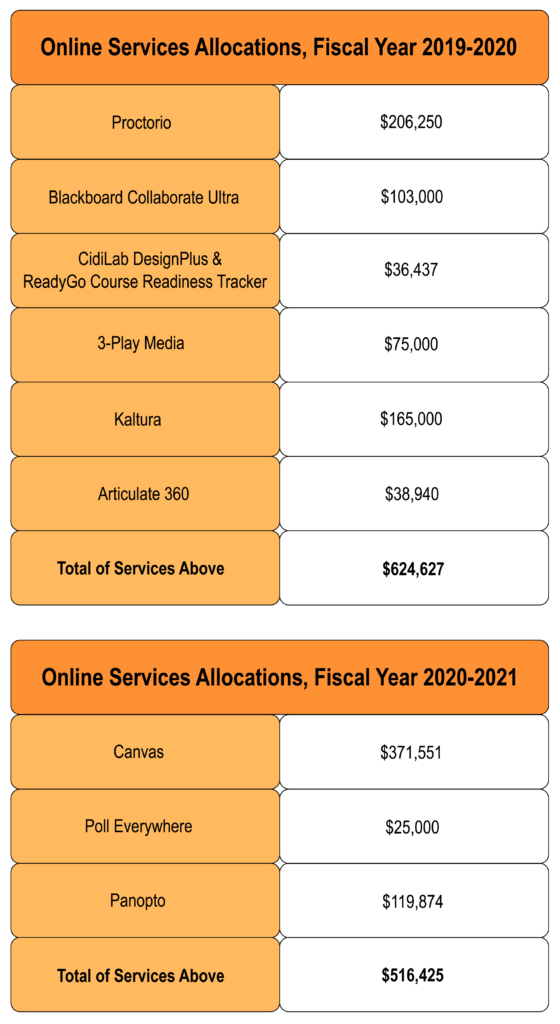Pictured Above: The past three semesters, students have found themselves spending days in front of the computer using online services like Canvas, which the university uses as a class dashboard.
Courtesy of Tara Zimmerman
By Sophie Ojdanic and Catherine Hicks
In an academic year plagued by the pandemic, almost every student is learning virtually. With this shift, the university is working through adjustments to online services as well as innovative ways to keep students engaged and information accessible.
According to Chief Information Officer Sidney Fernandes, $371,551 was budgeted for Canvas in fiscal year 2020-2021. Poll Everywhere, which allows faculty to conduct polls, is $25,000, while Panopto, a service used to record lectures, is allotted $119,874.
While other allocations were not provided for the 2020-2021 fiscal year, the 2019-2020 fiscal year’s allocations included:
** $206,250 for Proctorio, a remote exam proctoring system.
** $103,000 for Blackboard Collaborate Ultra, a virtual classroom service.
** $36,437 for CidiLab DesignPlus and ReadyGo, two Canvas tools.
**$75,000 for 3-Play Media, a course transcription tool.
**$165,000 for Kaltura, which records and stores video.
**38,940 for eLearning development software Articulate 360.

Darnell Henderson | The Crow’s Nest
Cynthia DeLuca, associate vice president for innovative education, said costs for online services vary based on how they are used.
“I can tell you for proctorio (before the pandemic), we might have used proctorio on 200,000 exams,” DeLuca said. “During the last few semesters, we’ve administered over 800,000 exams using proctorio. But we were lucky because that price didn’t fluctuate because of the way the contract was written. So we were able to offer that (for) many more (courses) without increasing the cost to the university.”
Fernandes said IT’s main goal during the pandemic is to serve the students.
“The pressure has been immense, because … we have very little room for error when the entire university is running on infrastructure that, if it doesn’t work, there’s no physical alternative,” Fernandes said. “(We’re) more digital than we’ve ever, ever been.”
This fully digital landscape provided challenges that were unforeseeable to administrators and placed a burden on staff and faculty to devise a solution.
Some of the CARES Act funding provided to the university was used to alleviate this stress.
“From an IT perspective, … we need (to accommodate) faculty in the classroom, the student in the classroom and potentially the student at home,” Fernandes said. “And so for that we had to invest in technologies within the classroom as well as the infrastructure. So we did use CARES funding for that.”
CARES funding also contributed to the creation of the university’s return to campus pass.
Following the move to distance learning, online services was only one of the areas that was faced with unprecedented challenges.
Fernandes said budgetary factors were not the only concern over the sudden overhaul of online services.
“We had to create multiple modalities to be able to support the faculty and students,” Fernandes said. “I call it the COVID(-19) experience … But it’s nowhere close to where we would like to be if there was no COVID(-19).
“… You shift (to) ‘this is how we’re teaching our students,’ and then in a week, you have to shift elsewhere; that required, you know, investment of dollars as well as people and that’s hard to quantify.”
Strategic realignment will have less of an impact on the IT and Innovative Education departments, according to DeLuca.
“We were able to utilize, obviously, some of the CARES money in helping us to offer quality in the number of online courses and hybrid courses that we offered during this pandemic,” DeLuca said. “…We did, as every other unit, experience some budget cuts (in strategic realignment), but not to the extent that we feel that it will impact the design and development of quality online courses.”
One of the chief concerns of students and faculty this academic year has been availability and access.
“The home has now become part of the ecosystem that technologists like me now have to worry about, versus just having to worry about the bandwidth, for example, on campus,” Fernandes said.
Students may find themselves unable to upgrade their internet at home, or even access the internet, making it more difficult to complete virtual classes.
According to Fernandes, the IT department has made changes to on-campus bandwidth to allow for more users at the same time.
Fernandes remains open to feedback and “opportunities to get better.”
As COVID-19 vaccinations continue to be distributed to the highest-risk populations, the timeline for a return to normal is still shrouded in uncertainty.
Regarding the online services budget in the future, Fernandes hoped for “the ongoing costs to be as reasonable as possible.”
But, he said, “I think the pandemic will decide.”



